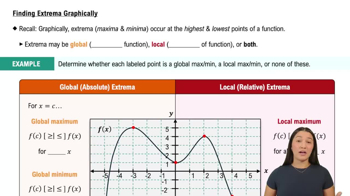Table of contents
- 0. Functions7h 52m
- Introduction to Functions16m
- Piecewise Functions10m
- Properties of Functions9m
- Common Functions1h 8m
- Transformations5m
- Combining Functions27m
- Exponent rules32m
- Exponential Functions28m
- Logarithmic Functions24m
- Properties of Logarithms34m
- Exponential & Logarithmic Equations35m
- Introduction to Trigonometric Functions38m
- Graphs of Trigonometric Functions44m
- Trigonometric Identities47m
- Inverse Trigonometric Functions48m
- 1. Limits and Continuity2h 2m
- 2. Intro to Derivatives1h 33m
- 3. Techniques of Differentiation3h 18m
- 4. Applications of Derivatives2h 38m
- 5. Graphical Applications of Derivatives6h 2m
- 6. Derivatives of Inverse, Exponential, & Logarithmic Functions2h 37m
- 7. Antiderivatives & Indefinite Integrals1h 26m
- 8. Definite Integrals3h 25m
5. Graphical Applications of Derivatives
Intro to Extrema
Problem 4.1.73
Textbook Question
Trajectory high point A stone is launched vertically upward from a cliff 192 ft above the ground at a speed of 64 ft/s. Its height above the ground t seconds after the launch is given by s = -16t² + 64t + 192, for 0 ≤ t ≤ 6. When does the stone reach its maximum height?
 Verified step by step guidance
Verified step by step guidance1
Identify the height function given by s(t) = -16t² + 64t + 192, which is a quadratic function in the standard form s(t) = at² + bt + c.
Recognize that the maximum height of a quadratic function occurs at the vertex. For a quadratic in the form s(t) = at² + bt + c, the t-coordinate of the vertex can be found using the formula t = -b/(2a).
In this case, identify the coefficients: a = -16 and b = 64.
Substitute the values of a and b into the vertex formula to find the time t at which the maximum height occurs: t = -64/(2 * -16).
Calculate the value of t to determine when the stone reaches its maximum height, ensuring that the result falls within the given interval 0 ≤ t ≤ 6.
Was this helpful?

 5:58m
5:58mWatch next
Master Finding Extrema Graphically with a bite sized video explanation from Callie
Start learning





